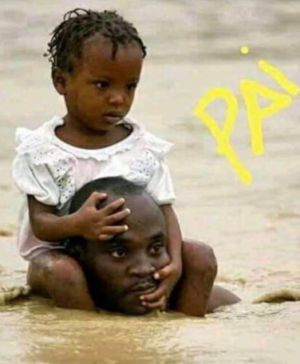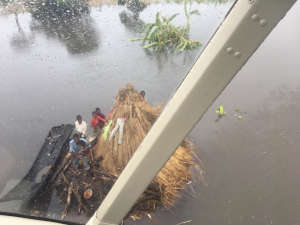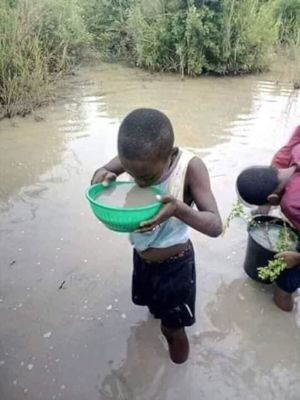News
[Sources: Bishop Carlos Matsinge, Bishop of Lebombo - 22 March 2019]

We had been cut out from our Beira community since the night of March 15 when the cyclone Idai hit the region very, very badly. There was no communication at all and we did not know who, from our congregation might have survived the storm. I undertook the visit 5 days after the Beira Airport was re opened again after the storm. Just the night before my flight I was lucky to reach Nilton Mazithemba (ORAM) staff by Movitel service provider and he assured me that we could do some driving around the city to locate and meet a few people. Arriving at Beira Airport at about 8.30h I had to register myself and on behalf of the Anglican Church at OCHA (United Nations Office for the Coordination of Humanitarian Affairs) already based in Beira. I realized that the Airport had given space for all national and international coordination and I met and talked to INGC (National Institute for the Management of Natural Calamities) related staff who provided me relevant updated information related to my facts findings visit. Then Mr. NIltom Mazithemba took me down town. I visited our new church which has literally been crashed down. I saw also churches of other denominations that have also been destroyed in town except our little chapel at Munhava, which was, of course the refuge of many people living around it. I visited the Rector, Archdeacon and his family whom I found busy repairing and cleaning their house. I visited 5 homesteads to meet the church wardens and a few Christians in order to inform them of our prayers and solidarity at this critical moment. I visited an Accommodation Center at Escola Amilcar Cabral hosting 600 people inside classrooms where they all stay and sleep and each family kooks it own food. At the time they were short of food and water and there was a clear evidence that hygiene was not there. I had the chance to talk with the Sofala Governor at the Airport immediately after daily evaluation and planning activities. He appealed for prayers and material support.

The general picture is that of a devastated and destroyed city. Is estimated the 95% of the buildings were damaged, with roofs blown out. The roads were blocked by broken or uprooted big trees. One could see piled rubble and scattered roofing tins everywhere and most of the houses I entered were dripping water. Beira surface is below sea water level and the soil is mud and swampy and therefore water everywhere though they talked about some improvements. The electricity grid has been pulled down by the cyclone and there is no running water. The population survives either by rain collected water or by water from open sky collective wells which can easily be contaminated. Sewerage system not secure because water level is up or above surface. Human dejections and waste are likely to contaminate those sources of water and cause diarrhoea and cholera or other similar diseases that can be deadly at this time of human crisis that region. The state of destruction has also taken place in the country side hit by the cyclone in the provinces of Sofala, Manica and part of Tete.
Up to yesterday there were no sufficient food and medical supplied in town. The shops had been closed and those that are open are selling food products and other necessities that had been in stock before the cyclone. Many shops have not opened since after the damage by the cyclone. Shopkeepers have started to increase the prices of commodities. Since the main road connecting Beira to the rest of the country is cut off in 4 sections over the Pungue river and trucks with emergency and general supplies cannot reach Beira, and currently, emergence supplies are to being air lifted. There are hopes of a ship bringing rice to reach the Beira port any day soon. Nevertheless much is being done to re-establish connection between the city and the inland.

As all should know, this cyclone Idai is rated as the strongest and most devastation climate disaster even seen in the southern hemisphere. This should tell you how dreadful its effects have been. And it will take many years to recover from its long term impact in human and economic life of the region. Official records given as per 21st March indicates the number of 242 death in the affected region and the State president, speaking during his visit to Beira, said that the toll may reach 1000 or more as the number increases day after day with more people found dead as rescue operations reach new places. The number of affected needing immediate emergency assistance in the whole of Sofala and Manica is 180.000 as per March 21th. Following the city of Beira other districts such Dondo, Buzi, Nhamatanda, Gorongoza; Marromeu, Caia, Chemba, Machanga and Chibavava are also affected with the overflow of the rivers in those areas and it is feared that more people might die if the dams are opened since they are receiving a lot of water from the rainfalls in neighbouring countries such as Zimbabwe and Malawi. 6 South African helicopters are assisting in rescuing the people of Buzi found on the trees, roof tops and other so far higher places. No one has the count of who has died already in that district which is under water. These rescuers bring new stories of how terrible and bleak the situation is. Television images as well show that we stand before a far reaching human crisis. Last minute news indicate the Beira Hospital has been closed today of because of the state of destruction and lack of basic conditions. Tents from which to run health services are to be built around hospital. This tell you how terrible the condition are and may be.
The crisis is even bigger because the Province of Zambezia (which is part of the Diocese of Niassa for Anglicans) has been under floods along the rivers even before the Beira Cyclone.
This cyclone has equally affected Zimbabwe and Malawi badly where also many people were killed (so far 139 for Zimbabwe and 56 for Malawi)
77.418 affected families
344.811 people affected
1.511 people injured
293 deaths
15.384 houses partially destroyed
15.782 houses totally destroyed
2.867 classrooms destroyed
86.056 school children affected
43 Health units destroyed
345.364 hectors of crops have been destroyed
Livestock washed away in the flooded regions
65.000 people are in temporary accommodation centre basically schools in Beira city
46 schools turned into accommodation centres in Beira, Dondo and Nhamatanda
In these places of concentration there is a high risk of diseases outbreak because of the sanitary conditions and lack of running water. Work is being done to restore water supply in Beira.
95% of buildings in Beira damaged especially the roofs
Roads damaged including the main road connecting Beira to the rest of the country. Currently no aid can reach Beira through road. The National Roads Authority speaking yesterday said they will need at least 10 days to re-establish connection between Beira and Nhamatanda. This connection is most important. Right now the emergency supplies are sent to Beira through ship.
While we have the above official numbers of affected people it is important to acknowledge that there will be many more people affected in the isolated areas of the whole region. There have been an indication that not less than 400.000 people will be affected. The above data increases every day as more rescue work is done.
The living conditions of those in accommodation centres present greater risks especially considering the limitation of sanity facilities and water for many people sharing. I have been informed that the government is planning to move out the people accommodated in the schools to settle them outside the city when rain has stopped and when tents are available. Whether still in town or after moving them to a settlement we need to take care of sanitation in order to prevent the outbreak of diseases such as cholera and malaria (we need water, domestic utensils, hygienic materials, mosquito nets and or repellents). There
Children will soon need to go back to school and the need to support them with school needs such as: Exercise books, pens, backups, shoes, uniform, diverse clothing, blankets, bolls, and games
The food situation is presently critical this week. The quantities provided for people who at Beira accommodation centres is not sufficient compared to the need. See yesterdays official numbers:
In Beira our new church was crushed down, the rectory lost its roof and the old and small church had its roof also partially destroyed. 4 families had the houses destroyed and almost every family has a house partially damaged. But there was no injury or death among members.
In the other districts that have been affected we have no information about the safety of our members because these districts remain isolated without any kind of communication. We know Fr. Araujo and his family at St. Mary Mutua in Dondo is well but his house and church were partially damaged. We do not know anything about Father Domingos Chipuazo at All Saints of Nhamatanda. We do not know about the safety our members in these most hit and flooded until communication is restored. What we imagine is that since most of our outstation churches are made of local bricks and mud and roofed either with grass or zinc sheets, like the houses of the population they have been destroyed.
In Chimoio, one of our concrete church building, The Holy Family Church, is one of the accommodation centre. Around this church 58 houses were destroyed and 48 families found accommodation in this church. I hope to provide more data about the state of our churches and communities as soon as we have them. But in general their conditions and needs are the same as described in the previous sections.
From the contacts with other Institutions and NGOs I am convinced that is few days there will be enough food supply for the emergency although we do not know how long the emergency will last. Internal solidarity is growing as is the international one. But more than the supplies is the need service capacity. I have noted in Beira that the Health sector has pulled together health workers from different provinces to come and help in Beira. Also a number of National and International NGOs are building joint efforts to respond to the crisis.
At this point it is important to think and plan the post emergency phase.
The Rt. Revd. Carlos Matsinhe
Bishop of Lebombo
22 March 2019